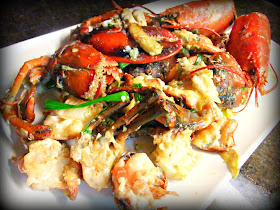The Rooster will crow its infamous crow to welcome 2017, a new lunar year celebrated across Asia January 28th. It was a privilege along with my mother to check out Korean Galleria Supermarket's York Mills location last Friday as they kicked off the year with a multiple "Asian fondue" demonstration. Sponsor products included condiments and sauces from Lee Kum Kee and seafood from Anchor's Bay. Host chef Sang Kim, award-winning author, chef and restaurateur (Toronto's Blowfish, Ki Modern Japanese, Ame Cuisine, KOKO! Share Bar and more) showcased how hot pot traditions are famously celebrated in China, Japan and South Korea in their distinctive styles and ingredients. During new year, this do-it-yourself experience becomes a special gathering for family and guests at the table to cook their favourite foods in one or two large communal pot(s) of simmering broth. Across the countries, this meal ritual is meant to bring good luck, peace and happiness to the entire family.
Well-organized and interactive, the event was a fun tasty experience with guests parting with a generous tote of Galleria and sponsor products to enjoy at home!
 |
| Chef Sang Kim |
 |
| Media press and guests enjoy the experience first-hand. |
The first demo introduced China's hot pot otherwise known as Mongolian fire pot. Two broth bases were featured in one pot separated by a divider. Yin- seafood, and yang- spicy Szechuan. The ingredients included sliced lamb, sliced beef rib eye, shrimp, fish ball, bean curd, tofu, napa cabbage, watercress, enoki, mushrooms and potato. The raw meat and vegetables cook quickly, thus a few minutes will do, and tasty morsels are fished out with basket ladles into individual bowls, to be dipped into your choice of sauce and eaten right away.


For the Chinese hot pot, dipping sauce is an important aspect since the food is rather bland by boiling. The customize-your-own combination can include soy sauce, sesame oil, chilli oil or sauce, shrimp paste, sesame paste, preserved red bean curd, chopped green onions, cilantro, garlic, vinegar, sugar and wine. A fresh raw egg can also be cracked into the sauce concoction to bring down the heat of the ingredients (yang) before dipping and eating. Note the soup becomes rather rich and flavourful as you go from cooking all the delicious variety of foods in it, and more soup/water is added to replace the amount that has been boiled away or scooped up. At my home, we always finish our hot pot meal with flat rice noodles (ho fun) bathing in the tasty broth, and slurp our way to the end.
 |
| Lee Kum Kee's assortment of condiments and sauces perfect for dipping. |
 |
| This dual soup pot allows for double the flavours and fun! |
 |
| A rare photo of my mum and me. |
Next was Japanese hot pot, also called sukiyaki (literally meaning "to grill on a flat spade"). A heavy-walled shallow skillet is most suitable for cooking sukiyaki. The base here is a sweet soy sauce (made with soy sauce, sake and sugar- a definitive characteristic of home-style Japanese cuisine) and only requires a shallow amount to simmer-cook the ingredients. Sliced beef is most popular, clam, scallop, napa cabbage, watercress, onion, enoki mushrooms, shiitake mushrooms, tofu and yam noodles were also enjoyed. A distinct difference between Japanese hot pot to Chinese is that it does not require any dipping condiments. The broth imparts its light sweet and savoury flavours while enhancing the foods' tastes when cooking. Served over hot rice, the umami flavours are soaked up and each bite becomes more irresistible and full-filling.
Sukiyaki is traditionally done with beef but seafood is complementary and can be added too.
The last demo was the most noteable for me as I was least familiar with Korean hot pot. There are several varieties but the one chef Kim showed us was Korean Army Stew or Army Base Stew (Budae Jigae), and is apparently one of the most popular hot pot dishes in Korea. It uses a seasoned hot pepper paste and flakes to make the base for the broth. Some out-of-the-ordinary ingredients such as Spam, sausage, processed cheese, as well as tofu, king mushrooms, kimchi, rice cake, instant noodles and green onions make up this hearty and highly-addictive stew. Interesting facts I've learned-- soon after the Korean war (in the early 1950’s), food was extremely scarce so surplus processed foods from the US military bases were a great supplement for the Koreans, thus the creation of army stew-- a Korean-American fusion stew that incorporates processed foods such as Spam, sausages, canned baked beans and sliced cheese. An unusual combination at first, but no doubt was it savoury and delicious!
 |
| There's that slice of processed cheese. |





























































